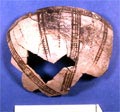 |
| Map of Cyprus |
 |
| Phlamoudhi Village |
 |
| Phlamoudhi-Melissa |
 |
| Phlamoudhi-Vounari |
 |
| Red-onBlack bowl from Vounari |
 |
| Mycenaean pots from Melissa |
 |
| White Slip bowl from Melissa |
 |
| Storage pithos vessel at Melissa |
 |
| Impression of seal from Melissa |
 |
| View from Vounari to Melissa |
 |
| The Kyrenia mountains |
Settlement and Sanctuary on Cyprus from the Bronze Age to the Middle Ages: Views from the Columbia University Excavations at Phlamoudhi
January 20-March 19, 2005 ~ Miriam and Ira D. Wallach Art Gallery ~ Columbia University
[download]
> For additional information, go to the Miriam & Ira D. Wallach Art Gallery
> Directions to the gallery
In 1970, the Columbia University Expedition to Phlamoudhi began a survey and excavations in and around the north coast village of Phlamoudhi, Cyprus. This field project, led by the late Professor Edith Porada, continued through 1973. Among their discoveries were a settlement at Melissa and a sanctuary at Vounari , both of which were occupied in the Late Bronze Age (c. 1650-1200 BCE) and used during the Archaic through Hellenistic periods (c. 750-100 BCE). Surface finds also attest to activity during Roman, Medieval, and lter times. Since the division of the island in 1974, these and other northern sites have been inaccessible for detailed study.
Most records and objects from the Phlamoudhi excavations were brought back to Columbia by Edith Porada for study. The Vounari sanctuary was published in 1983. Since 2000, the Phlamoudhi Archaeological Project's work, led by Joanna S. Smith, toward the publication of the Melissa settlement has been intensive and is now near completion. From January 18-March 19, 2005, a public exhibition in Columbia's Miriam and Ira D. Wallach Art Gallery, Settlement and Sanctuary on Cyprus from the Bronze Age to the Middle Ages: Views from the Columbia University Excavations at Phlamoudhi, will display the exciting finds from Phlamoudhi for the first time. Following the exhibition, the finds will return to Cyprus.
Throughout their histories, Melissa and Vounari were parts of a lively north coast tradition as well as the international Mediterranean world. The Late Bronze Age ceramic workshop at Melissa made red-slipped vessels, including Red-on-Black examples that were used at Vounari. Ceramic imports from the Mycenaean world, Levant, and southern Cyprus also contributed to ceramic experimentation at Melissa .
A monumental building at Melissa housed large quantities of olives, olive oil, and other food and drink in decorated and human-scale storage vessels called pithoi. Those food resources may have served the entire community, including people at the hilltop of Vounari. Gold, ivory, and carnelian jewelry as well as a cylinder seal and a scepter-head attest to the wealthy nature and international connections of some Melissa residents.
Sanctuaries in the Bronze and Iron Ages were important cultural centers and boundaries; that at Vounari and those at Melissa in the Iron Age help us to define the cult activities as well as the territory of those who lived in Phlamoudhi in the past. International as well as on-island contacts continued into the Roman and later periods, including the 1970s when the Columbia Expedition to Phlamoudhi began.
Settlement and Sanctuary will recreate parts of the fascinating art, archaeology, and history of the Phlamoudhi region, bringing to life once again the traditions and innovations of this coastal area north of the Kyrenia mountains of Cyprus.

